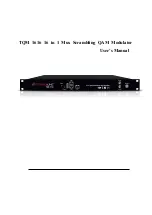
FEC920: USER GUIDE
Page 95
September 18
Pending: The request is waiting to be sent, the most likely cause being that the slave
device has not been set to online.
Slave Device
A list of available slaves that this data is to communicate with.
Parameter List
List of parameters available for the selected slave devices profile. These parameters
require no user configuration.
Number
The channel, loop or group etc. instance.
Modbus Address
The Modbus register address that this data is to be read or written to. Limits are 0 - 65535.
Function Code
The function code to use, this determines if the data is going to be read or written to the
selected slave. Supported function codes are:
Data Type
The data type that defines how this data is going to be represented. The data types listed
below are supported.
8-bit signed byte (BYTE)
8-bit unsigned byte (UBYTE)
16-bit signed integer (INT)
16-bit unsigned integer (UINT)
32-bit signed long (DINT)
32-bit unsigned long (UDINT)
32-bit floating point IEEE (REAL)
32-bit signed long (little Endian, word swapped) (DINT (Swap))
32-bit unsigned long (little Endian, word swapped) (UDINT (Swap))
32-bit floating point IEEE (little Endian, word swapped) (REAL (swap))
Bit from register (BIT)
By default all 16 & 32 bit data types (unless specified) will be transmitted in Big Endian
format, where the most significant byte in the value is sent first. Byte Ordering: (for big
Endian) (0x12 sent first)
16-bit
0x1234
0x12, 0x34
32-bit
0x12345678
0x12, 0x34, 0x56, 0x78
Bit Position
The bit in the register to be extracted, this is only available if the 'Data Type' selected is
'BIT In Register'.
Scaling
The decimal placing for scaled 16 bit data types. Visible depending on the 'Data Type'
selected.
Priority
The frequency with which this data will be managed. See ‘PRIORITY LEVELS’, in Section
6.6.1, above.
6.7 ETHERNET/IP CONFIGURATION
This area of configuration allows the ‘Client’ user to set up an EtherNet/IP communications link with up to two
Server units. The ‘Server’ user has a more limited range of configurable items.
Note:
Implicit I/O is used for continuous real-time transfer of multiple data items from instrument to
instrument. Explicit I/O is used as a ‘one-shot’ transfer of a single data item. See Section 5.4.8
for further details.
Figure 85 shows that the configuration is split into three areas: Main, Implicit Inputs and Implicit
Outputs, but it should be noted that the implicit inputs and implicit outputs are read only, as
these can be configured only by using iTools, as described in the EtherNet/IP display mode
description (Section 5.4.8).
Code
Code
Description
Description
1
2
3
4
5
6
8
16
Read contiguous status coils
Read contiguous discrete inputs
Read contiguous holding registers
Read contiguous input registers
Write a single coil on or off
Write to a single register
Loopback test
Write to contiguous registers
A5E45696052A Rev-AA
Содержание SITRANS FEC920
Страница 1: ...Flow Energy Calculator FEC920 User Guide A5E45696052A Rev AA September 2018 ...
Страница 247: ......














































